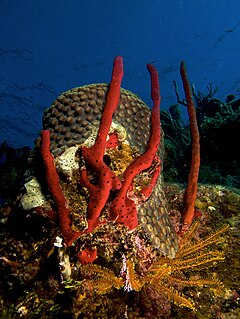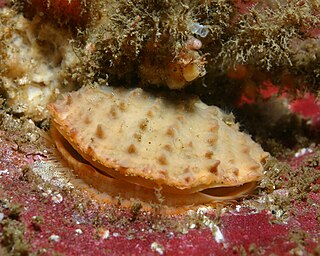
Cliona celata, occasionally called the red boring sponge, is a species of demosponge belonging the family Clionaidae. It is found worldwide. This sponge creates round holes up to 5 millimetres (0.20 in) in diameter in limestone or the shells of molluscs, especially oysters. The sponge itself is often visible as a rather featureless yellow or orange lump at the bottom of the hole.
Cliona californiana, the yellow boring sponge, boring sponge or sulphur sponge, is a species of demosponge belonging to the family Clionaidae. It is native to the north-eastern Pacific Ocean and burrows into the shell valves of bivalve molluscs.

Doriopsilla albopunctata is a species of dorid nudibranch, a colourful sea slug, a shell-less marine gastropod mollusk in the family Dendrodorididae.

Doriprismatica sedna is a species of colorful sea slug, a dorid nudibranch, a marine gastropod mollusk in the family Chromodorididae.
Felimare agassizii is a species of sea slug or dorid nudibranch, a marine gastropod mollusk in the family Chromodorididae.

Clionaidae is a family of demosponges which are found worldwide. This family is known for parasitically boring holes in calcareous material such as mollusc shells and corals, using both chemical and mechanical processes.

Amphimedon compressa, the erect rope sponge, red tree sponge, red tubular sponge, or red sponge is a demosponge found in southern Florida, the Caribbean Sea, and the Bahamas. It can be deep red, orange, brown, or black.
Dragmacidon lunaecharta, common name red ball sponge or red boring sponge, is a species of demosponge found through the western Atlantic Ocean. It feeds on plankton. These sponges do not attach themselves to rocks or the sea floor but drift in water currents. Its main predators are seaslugs. It has been kept in home aquariums.
Sea sponge aquaculture is the process of farming sea sponges under controlled conditions. It has been conducted in the world's oceans for centuries using a number of aquaculture techniques. There are many factors such as light, salinity, pH, dissolved oxygen and the accumulation of waste products that influence the growth rate of sponges. The benefits of sea sponge aquaculture are realised as a result of its ease of establishment, minimum infrastructure requirements and the potential to be used as a source of income for populations living in developing countries. Sea sponges are produced on a commercial scale to be used as bath sponges or to extract biologically active compounds which are found in certain sponge species. Techniques such as the rope and mesh bag method are used to culture sponges independently or within an integrated multi-trophic aquaculture system setting. One of the only true sustainable sea sponges cultivated in the world occur in the region of Micronesia, with a number of growing and production methods used to ensure and maintain the continued sustainability of these farmed species.

Serpula vermicularis, known by common names including the calcareous tubeworm, fan worm, plume worm or red tube worm, is a species of segmented marine polychaete worm in the family Serpulidae. It is the type species of the genus Serpula and was first described by Linnaeus in 1767. It lives in a tube into which it can retract.

Crassadoma is a genus of rock scallops, marine bivalve molluscs in the family Pectinidae. It is monotypic, the only species being Crassadoma gigantea, the rock scallop, giant rock scallop or purple-hinge rock scallop. Although the small juveniles are free-swimming, they soon become sessile, and are cemented to the substrate. These scallops occur in the eastern Pacific Ocean.

Mycale laevis, the orange icing sponge or orange undercoat sponge, is a species of marine demosponge in the family Mycalidae. Mycale is a large genus and this species is placed in the subgenus Mycale making its full name, Mycale (Mycale) laevis. This sponge is found in the Caribbean Sea and the Gulf of Mexico and usually grows in association with one of a small number of species of coral.

Pione Sisto Ifolo Emirmija is a South Sudanese-Danish professional footballer who plays as a left winger for Spanish club Celta de Vigo and the Danish national team.

Cliona viridis, commonly called the green boring sponge, is a species of demosponge in the family Clionaidae. Its form varies according to the nature of the surface on which it grows. In limestone and other calcareous substrates it excavates channels and chambers while on other types of rock it encrusts the surface or forms massive structures. It is native to the eastern Atlantic, the Mediterranean Sea and the Indo-Pacific Ocean.

Oulophyllia crispa, sometimes called the intermediate valley coral, is a species of stony coral in the family Merulinidae. It is native to the tropical western and central Indo-Pacific region. Although this coral has a wide range, it is generally uncommon and seems to be decreasing in abundance, and the International Union for Conservation of Nature has rated its conservation status as being "near threatened".
Sponge grounds, also known as sponge aggregations, are intertidal to deep-sea habitats formed by large accumulations of sponges, often dominated by a few massive species. Sponge grounds were already reported more than 150 years ago, but the habitat was first fully recognized, studied and described in detail around the Faroe Islands during the inter-Nordic BIOFAR 1 programme 1987–90. These were called Ostur by the local fishermen and this name has to some extent entered the scientific literature. Sponge grounds were later found elsewhere in the Northeast Atlantic and in the Northwest Atlantic, as well as near Antarctica. They are now known from many other places worldwide and recognized as key marine habitats.
Boring sponge may refer to three different species of sponges:













